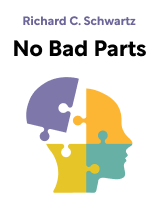

This article is an excerpt from the Shortform book guide to "No Bad Parts" by Richard C. Schwartz. Shortform has the world's best summaries and analyses of books you should be reading.
Like this article? Sign up for a free trial here.
What is IFS therapy? What psychological wounds is IFS used to treat?
Internal Family Systems (IFS) is an integrative and evidence-based method of psychotherapy developed by Richard Schwartz. IFS-trained therapists use questions, suggestions, and active listening to guide clients through the process of getting to know their inner family system and healing their wounded parts.
To understand IFS therapy, it’s important to first understand the two foundational concepts on which it’s built: multiplicity and systems thinking.
Multiplicity of the Self
The pervasive theory of the self in psychology proposes the existence of one mind, referred to by the author as the “mono-mind,” from which all thoughts and feelings emanate. This theory suggests that everything we think, feel, imagine, and desire comes from a singular, unified self.
Schwartz argues that the “mono-mind” conception of self is not only false, but damaging. The problem with this paradigm, according to Schwartz, is that if we’re only one thing, then any shameful, violent, or otherwise socially unacceptable thought or emotion challenges our core identity. We then feel obligated to suppress or control those parts of who we are, resulting in feelings of self-hate, shame, and anxiety.
He proposes an alternative concept of self in which we all have a core Self and a “multiplicity” of parts inside of us, none of which are inherently bad, and all of which want what’s best for us. This concept of internal multiplicity flies in the face of longstanding cultural norms that frame the idea of multiple selves as a product of emotional damage or mental illness (for example, Dissociative Identity Disorder, formerly known as Multiple Personality Disorder). Schwartz explains that honoring, instead of pathologizing, our multiplicity allows us to see every part of who we are as deserving of attention and compassion.
Schwartz emphasizes that our internal parts aren’t metaphors or symbols but beings with their own complex thoughts, emotions, and motivations. If you haven’t explored this concept before, it can be hard to imagine. Imagine you’re debating whether to attend a party. You might notice that one part of you really wants to go–it says you’ll have fun and meet new people–while another part of you might caution you to stay home because you probably won’t know anyone and will feel out of place. These two internal monologues are different internal parts that have conflicting motivations: The first one wants to help you expand your horizons, while the second wants to protect you from rejection.
Systems Thinking
The concept of multiplicity is the first step in understanding the Internal Family Systems model. Next is the concept of systems thinking. In this section, we’ll briefly describe systems thinking as it relates to the family systems theory that inspired Schwartz to develop IFS.
Systems thinking is the idea that we can’t understand something by looking at its parts in isolation. Exploring the relationships and patterns within a system helps us to understand both the whole and the parts. Consider how an ecosystem works. We can better understand a species of flora or fauna by observing how it relates to and interacts with other species in the environment.
In psychotherapy, the Family Systems Theory uses systems thinking to understand the family as a whole unit. The theory argues that instead of diagnosing a child in isolation, therapists should work with a child within their family context—noticing how family members relate and interact, considering what roles different family members take on, and confronting unconscious values and beliefs. For example, in a family where the parents are often in conflict, a child may take on the role of the mediator, believing that they’re responsible for keeping the peace in the household.
IFS suggests that, just like in a family, our internal parts interact with each other in a similarly complex web of relationships, often taking on well-intentioned but unhealthy roles. (
| Criticism of IFS While Richard Schwartz’s IFS is considered an evidence-based practice, it’s not without criticism. The dominant critique of IFS is that it lacks empirical data or any long-term studies that prove the efficacy of IFS as a therapeutic tool. Moreover, IFS was at the center of a 2011 controversy regarding the potential of the therapy to uncover repressed memories. That year, Anna, a 15-year-old girl suffering from anxiety, self-harm, and an undiagnosed eating disorder, was admitted to Castlewood, a residential mental health treatment center near St. Louis, Missouri. While there, she participated in IFS therapy. In her sessions, Anna recovered repressed memories of being sexually abused by her father. While the family denied the accusations, the abuse was reported to Child Protective Services and Anna was permanently removed from her family. Anna was one of a number of controversial recovered memory cases linked to Castlewood Treatment Center. While some psychologists still believe in the potential for traumatic memories to be repressed, many argue that it is a dangerous myth with dangerous consequences in a therapeutic setting. Interestingly, while only 43% of clinical psychologists believe it is possible to retrieve repressed memories, 66% of Internal Family Systems therapists believe it is possible. |

———End of Preview———
Like what you just read? Read the rest of the world's best book summary and analysis of Richard C. Schwartz's "No Bad Parts" at Shortform.
Here's what you'll find in our full No Bad Parts summary:
- A detailed look at IFS—a psychotherapy model that challenges the idea of a unitary mind
- Why it's normal to have conflicting voices in your head
- What IFS therapy looks like in practice and its benefits






